
- Home
- Introduction
- History Speaks
- Transportation
- Public Services
- Commerce
- Sports
- Miscellaneous Stuff

|
Wind Fire & Water
1929 Flood, Queen Street north of the Teeswater Bridge |
|
1912 Flood Walter Stark recalls the flood of 1912 in a letter to the Advocate published May 3, 1962. “It was raining pitchforks and axe handles, but we were working on the dam, trying to keep open the slides, which were choking with brush and limbs that were left on the ice during the winter, when they timbered the flats below Donald Brown’s old place. However we fought a losing battle and almost lost Dad, who went over the dam that night. We found him down in the pasture field north of the two bridges (replaced). He was pinned against a stump. It took quite a number of stitches to close the cut in his head. There were quite a few down from town, holding lanterns and helping in any way they could. I can’t remember all the names, but I recall Paul Oltsher, ‘Thresher Jack’ Thompson, Stewart McLaren, and Harry Sergison. After Dad went overboard, all activity at the dam was forgotten as we tried to find him, and by the time we got that squared away, the water had all got around the wing wall and there was nothing more we could do only look on and ahead to a hard summer’s work to put it back in shape again. This was done before fall, and the old mill was rolling again.” |
|
1929 Flood - Church Street from Goldie Street hill, the Baptist Church is in the upper left. |
|
From the files of the Paisley Advocate, The first and heaviest property damage occurred early Friday morning, when Stark’s sawmill, together with about 100 ft. of the dam, was swept down by the overflow. The roadway leading to the town from the west was dangerously undermined and cave-ins had occurred, making it impossible to cross, and a long detour resulted. The Elora Road also was covered by several feet of water, and entrance to town by that main artery was impossible. The Saugeen River had passed the 1912 high water mark about midnight Saturday, and was still rising. Sunday morning dawned upon a water-ridden town. Pouring from behind the business places on Queen St. west, and from the cellar grates in front, the waters of the Teeswater flowed across the roadway to join its sister the Saugeen. Logs and lumber from the Carlaw Sawmill and debris from Stark’s Mill floated downstream, but was held by emergency booms strung up quickly at the north end of the bridge and at the corner of Queen Street and Church Street. Stores and storehouses on the east side of Queen Street were inches deep in water over the floors. At Riverside Park, the swift current carried away the poultry wing of the exhibition “palace”. Hundreds of feet of fence and the baseball screen backstop were torn away. The bandstand floated away, but lodged in the trees at the south end of the park. About 150 feet of the old stables were swept away. The race course was completely inundated except for the higher part of the home stretch. On Tuesday forenoon the big main building at the fairgrounds toppled over, and half an hour later the horticulture wing also went down. |
|
Hurricane Hazel - 1954 |
|
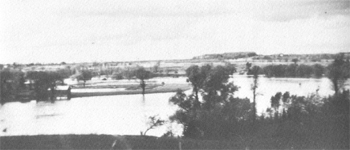 1954 - from Goldie St. Hill looking north |
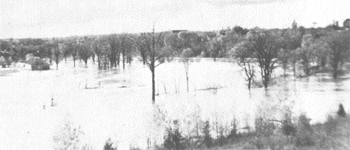 1954 - Fairgrounds, Palace to the left. |
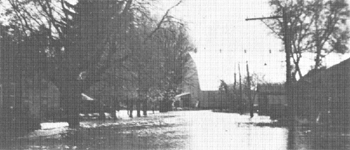 1954 - Ross St. looking south toward Arena |
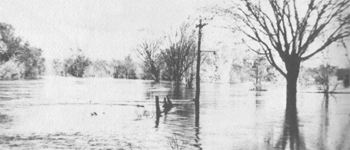 1954 - Water St. towards Fairgrounds |
 1954 - Looking north from the Saugeen Bridge towards the Baptist Church |
|
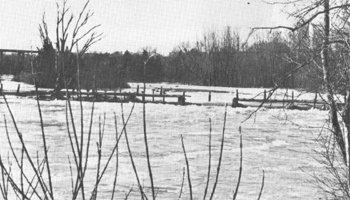 1974 - Fisher's Mill dam on Teeswater |
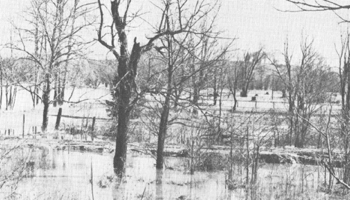 1974 - Looking easr toward the Fairgrounds |
| Return to top of Page | Return to top of Page |